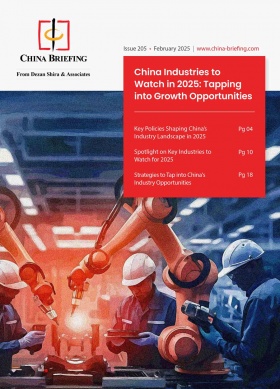China’s Economy in May 2025: Cooling Industrial Output, Resilient Consumption
China’s May 2025 economy data highlight resilient domestic consumption and strategic trade diversification as key stabilizers amid a slowing industrial sector, underscoring how the economy is adapting to external pressures with cautious optimism. Despite manufacturing headwinds and persistent deflationary trends, steady service growth and rising retail sales highlight a fragile yet hopeful recovery.
China’s economic performance in May 2025 confirmed a mixed pattern: factory growth slowed, yet household-driven consumption showed unexpected strength, offering a fragile offset amid ongoing trade pressures.
In many ways, the data released by the country’s National Bureau of Statistics (NBS) reflect the dual-speed nature of the recovery, where manufacturing momentum is cooling, consumers are cautiously stepping back into the spotlight.
This contrast is especially relevant against the backdrop of intensifying external pressures, particularly from the US tariff regime, which weighed heavily on China’s export performance to key markets. Still, authorities have leaned on domestic demand to stabilize growth, deploying a combination of fiscal nudges and retail-friendly incentives that seem to be gaining some traction.
Meanwhile, the labor market showed modest improvement, including a notable dip in youth unemployment, though it remains high. Deflationary pressures persisted, with price indicators still reflecting weak overall demand and subdued business confidence. All this points to an economy that is neither overheating nor collapsing, but rather one in delicate balance, requiring careful policy calibration as the year unfolds.
In this article, we break down the latest economic and trade data and assess the broader policy backdrop shaping China’s growth trajectory in 2025.
Key economic indicators – May 2025
- Foreign trade: RMB 3.81 trillion total trade, up +2.7% year-over-year (YoY), with exports reaching RMB 2.28 trillion, growing +6.3% YoY; and imports falling to RMB 1.53 trillion, declining –2.1% YoY.
- Industrial added value: +5.8% YoY, the slowest since November 2024 and down from +6.1% in April
- Service industry production index: +6.2%, slightly higher than the first-quarter pace and supported by booming digital and transport services
- Retail sales of consumer goods: RMB 4.13 trillion (US$574.94 billion), +6.4% YoY, the strongest increase since December 2023
- Fixed asset investment (Jan–May): RMB 19.19 trillion (US$2.67 trillion), +3.7% YoY. Excluding real estate, investment rose +7.7%; manufacturing investment surged +8.5%, while real estate dropped –10.7%.
- Urban surveyed unemployment rate: eased to 5.0%, down 0.1% from April
- Consumer price index (CPI): –0.1% YoY; the core CPI, excluding food and energy, rose +0.6%.
These May figures show trade and investment cooling, while robust retail sales and stable service-sector growth, highlighting a shift toward domestic demand as the engine of China’s economy.
China’s trade dynamics in May
China’s foreign trade performance in May 2025 presented a nuanced picture, characterized by a modest increase in exports coupled with a notable decline in imports.
In May 2025, China’s total imports and exports of goods reached RMB 3,809.8 billion, marking a 2.7 percent increase year-on-year. Specifically, exports were RMB 2,276.7 billion, up by 6.3 percent year-on-year, while imports totaled RMB 1,533.1 billion, a decrease of 2.1 percent year-on-year.
In dollar terms, exports recorded a year-on-year increase of 1.5 percent, reaching US$283.5 billion. Conversely, imports experienced a significant contraction, falling by 5.6 percent year-on-year to US$211.15 billion. This divergence resulted in a substantial trade surplus of US$72.35 billion for the month.
For the first five months of 2025 (January to May), China’s total imports and exports of goods amounted to RMB 17,944.9 billion, an increase of 2.5 percent year-on-year. Exports for this period climbed to RMB 10,668.2 billion, up by 7.2 percent, while imports declined by 3.8 percent to RMB 7,276.7 billion.
The modest export growth in dollar terms, alongside a considerable contraction in imports, illustrates an uneven trade performance. The large trade surplus, while seemingly positive, can be interpreted as a double-edged sword; it may reflect not only robust export competitiveness but also underlying weakness in domestic demand.
An examination of China’s trade performance with its major partners reveals significant shifts, indicative of ongoing diversification efforts and the direct impact of geopolitical dynamics.
|
China’s Trade with Key Partners (May 2025 vs. May 2024) |
||
| Partner | YoY % Change (Exports) | YoY % Change (Imports) |
| United States | -8.5% | -12.1% |
| European Union | 3.2% | -2.8% |
| ASEAN | 10.5% | 7.1% |
US Tariffs impact on China’s trade in May 2025
The impact of US tariffs on China’s trade in May 2025 is multifaceted, extending beyond direct bilateral trade figures to influence China’s broader trade strategy and global supply chain dynamics.
US tariffs significantly impacted China’s trade in May 2025, with a recent study estimating a 15-20 percent reduction in exports to the US for targeted goods. This directly correlates with the overall 8.5 percent year-on-year decline in China’s exports to the US, indicating a concentrated burden on specific sectors that are compelled to absorb costs, find new markets, or scale back production.
While these tariffs have imposed direct costs and forced market re-routing, China’s overall trade resilience has been maintained through strategic diversification. The decline in US trade has been partially offset by growth in other markets, suggesting that tariffs have not crippled China’s export machine entirely but have forced a significant reorientation of its trade flows.
The evolving dynamics of China’s trade relationships reveal a multi-faceted strategy aimed at enhancing its supply chain resilience and mitigating geopolitical vulnerabilities.
On the export front, there is direct evidence of China’s success in re-routing trade away from the US. This is particularly visible in the increased exports to the EU, which rose by 3.2 percent year-on-year, and especially to ASEAN, which surged by 10.5 percent year-on-year. This strategic diversification highlights the adaptability of Chinese exporters and underscores the growing importance of non-Western markets in China’s evolving trade landscape. It serves as a key mitigation strategy to offset potential disruptions or declines in trade with the United States.
Concurrently, and significantly influenced by external pressures, particularly the US’s semiconductor bans and broader export controls, there’s a significant 12.1 percent year-on-year decline in imports from the US and a 15 percent year-on-year decline in semiconductor imports. This strongly suggests a deliberate and accelerated shift in China’s import patterns. This indicates China’s intensified efforts to reduce reliance on US suppliers for critical goods and components. This reduction is being achieved either through diversified sourcing from other countries (complementing its export diversification efforts) or, crucially, through accelerated domestic production, as part of a broader, proactive strategy to enhance its own supply chain resilience and reduce vulnerability to geopolitical pressures.
China’s key economic indicators in May 2025
Industrial momentum eases in May despite resilient high-tech output
China’s industrial sector maintained a stable expansion in May 2025, though signs of cooling momentum are beginning to emerge. Official figures show that the value-added industrial output of large-scale enterprises rose 5.8 percent year-on-year, slightly below April’s 6.1 percent and the slowest growth rate since November 2024. On a month-on-month basis, industrial output increased by 0.61 percent.
Among the three major industrial categories, manufacturing maintained the strongest pace with a 6.2 percent year-on-year increase, followed by mining at 5.7 percent and utilities (including electricity, heat, gas, and water production and supply) at 2.2 percent. While these figures suggest continued expansion, the pace of growth has softened, reflecting broader headwinds ranging from property sector instability to global demand uncertainties.
Nonetheless, innovation-driven segments remained key engines of growth. Equipment manufacturing expanded 9.0 percent year-on-year, while high-tech manufacturing grew by 8.6 percent, outpacing overall industrial output by 3.2 and 2.8 percentage points, respectively. These sectors were further buoyed by strong production figures in emerging technologies:
- 3D printing equipment: up 40 percent year-on-year;
- Industrial robots: rising 35.5 percent year-on-year; and
- New energy vehicles (NEVs): up 31.7 percent year-on-year.
Growth across ownership types was uneven. Private enterprises saw a 5.9 percent increase in value-added output, while joint-stock companies expanded by 6.3 percent. Foreign invested enterprises, including those backed by Hong Kong, Macao, and Taiwan, grew by 3.9 percent, and state-owned enterprises (SOEs) lagged behind with a 3.8 percent rise.
Despite the slowdown in output growth, business sentiment improved modestly. The manufacturing Purchasing Managers’ Index (PMI) edged up to 49.5 in May, still in contractionary territory but up 0.5 percentage points from April. The business expectations index rose to 52.5, reflecting cautious optimism among manufacturers.
For the January–May 2025 period, industrial output increased 6.3 percent year-on-year overall, suggesting that China’s industrial base remains resilient overall. However, analysts warn that the second half of 2025 could bring renewed volatility, as the truce in US-China trade tensions remains fragile, with tariffs still levied on 55 percent of bilateral trade flows. Meanwhile, lackluster real estate investment and deflationary pressures continue to drag on industrial demand.
Service sector gains pace in May, led by modern industries and resilient domestic demand
China’s service sector continued to accelerate in May 2025, benefiting from strong growth in modern, technology-driven services and a steady recovery in domestic consumption. The services production index rose 6.2 percent year-on-year, a slight improvement over April’s six percent, signaling sustained momentum in the sector.
Key areas of growth included:
- Information transmission, software, and IT services, which surged 11.2 percent year-on-year;
- Leasing and business services, up 8.9 percent; and
- Wholesale and retail trade, expanding by 8.4 percent.
These subsectors notably outpaced the overall service industry growth, reflecting a broader shift towards knowledge-intensive and digital services. Over the first five months, the services production index grew 5.9 percent year-on-year, while revenue for large-scale service enterprises increased by 7.2 percent in the January to April period.
Business confidence showed modest improvement, with the official services business activity index rising slightly to 50.2 in May, indicating ongoing expansion. Particularly active were sectors such as rail and air transport, postal services, telecommunications, satellite transmission, and internet/IT services, all posting activity indices above 55, highlighting strong operational momentum.
Independent data from the Caixin China Services PMI echoed these trends, showing growth at 51.1 in May, the fastest pace in three months, driven largely by domestic demand. Employment in the sector showed signs of recovery, breaking a two-month contraction, though the picture remained mixed. Some companies trimmed staff to manage costs, while others expanded hiring to meet rising demand.
Consumer demand rises steadily in May, driven by upgrade-oriented spending and trade-in incentives
China’s retail sales continued their robust recovery in May 2025, with total retail sales of consumer goods reaching RMB 4.13 trillion (US$574.53 billion), marking a 6.4 percent year-on-year increase — the fastest pace since December 2023. This growth outpaced April’s 5.1 percent rise, reflecting strengthening domestic consumption supported by government policies and rising consumer confidence.
Highlights from the month include:
- Urban retail sales grew 6.5 percent year-on-year to RMB 3.61 trillion (US$502.19 billion);
- Rural retail sales increased 5.4 percent to RMB 527 billion (US$73.31 billion);
- Retail sales of goods rose 6.5 percent to RMB 3.67 trillion (US$510.51); and
- Catering revenue expanded 5.9 percent to RMB 458 billion (US$63.71 billion).
Notably, consumer demand for upgrade-focused and lifestyle-related products remained strong, propelled by ongoing trade-in subsidies and consumption incentives. Key product categories showing exceptional growth were:
- Household appliances and audio-visual equipment, soaring 53.0 percent year-on-year;
- Communication equipment, up 33.0 percent;
- Cultural and office supplies, increasing 30.5 percent; and
- Furniture sales, rising 25.6 percent.
Between January and May, total retail sales climbed 5.0 percent year-on-year to RMB 20.3 trillion (US$2.82 trillion). Online retail sales further accelerated, reaching RMB 604 billion (US$64.02 billion) with an 8.5 percent growth, including a 6.3 percent rise in physical goods sold online, which accounted for 24.5 percent of total retail sales. Retail sales of services also expanded 5.2 percent over the same period.
Supporting factors behind this momentum include:
- The consumer goods trade-in program, which has effectively stimulated upgrade purchases;
- A surge in online shopping ahead of key e-commerce events like “6.18”;
- Increased foreign tourist arrivals due to visa-free entry expansions; and
- Government consumption vouchers and subsidies distributed across major cities.
Looking ahead, analysts caution that without continued government stimulus, consumption growth may slow, especially as some local governments pause trade-in subsidies due to funding exhaustion.
China’s 6.18 shopping festival, originally launched by JD.com, is a major mid-year e-commerce event held around June 18 that drives nationwide online sales through discounts and promotions, now rivaling Singles’ Day in scale and influence.
Investment expands, driven by manufacturing and high-tech sectors
Fixed asset investment (FAI) in China continued to expand in the first five months of 2025, reaching RMB 19.19 trillion (US$2.64 trillion), up 3.7 percent year-on-year. Excluding real estate development, FAI grew by 7.7 percent, underscoring stronger momentum in productive sectors of the economy. On a month-on-month basis, FAI rose by 0.05 percent in May.
Manufacturing remained the strongest growth driver, with investment rising 8.5 percent, while infrastructure investment increased by 5.6 percent. In contrast, real estate development investment declined sharply by 10.7 percent, continuing to weigh down overall FAI performance.
Investment by sector showed a clear divergence:
- Primary industry: up 8.4 percent;
- Secondary industry: up 11.4 percent; and
- Tertiary industry: down 0.4 percent.
Private investment remained flat year-on-year. However, excluding real estate, private investment increased by 5.8 percent, indicating continued interest from the private sector in productive industries.
High-tech sectors sustained strong growth, driven by government policy support and rising demand for innovation:
- Information services: up 41.4 percent;
- Aerospace manufacturing: up 24.2 percent;
- Computer and office equipment manufacturing: up 21.7 percent; and
- Professional technical services: up 11.9 percent.
Despite the drag from the real estate sector, the steady rise in industrial and high-tech investment reflects China’s continued pivot toward innovation-driven growth and industrial upgrading.
Consumer prices remain subdued due to weak demand
China’s consumer prices edged lower in May 2025, reflecting continued soft demand in the economy. The national consumer price index (CPI) fell 0.1 percent year-on-year and declined 0.2 percent month-on-month. Core CPI, which excludes food and energy prices, rose moderately by 0.6 percent year-on-year, marking a 0.1 percentage point increase from April and indicating a mild pickup in underlying inflation.
Among categories, food, tobacco, and alcohol prices increased slightly by 0.1 percent year-on-year, with notable price movements including:
- An 8.3 percent drop in fresh vegetable prices;
- A 1.4 percent decline in grain prices;
- A 3.1 percent rise in pork prices; and
- A 5.5 percent increase in fresh fruit prices.
Other categories showed mixed trends:
- Clothing prices rose 1.5 percent;
- Housing prices increased marginally by 0.1 percent;
- Household goods and services rose 0.1 percent;
- Transportation and communication prices fell sharply by 4.3 percent;
- Education, culture, and entertainment prices grew 0.9 percent;
- Medical and healthcare prices increased 0.3 percent;
- Other goods and services surged 7.3 percent.
From January to May, the average CPI was down 0.1 percent year-on-year, underscoring persistent low inflation pressures.
Producer prices remained deeply negative. In May, the producer price index (PPI) fell 3.3 percent year-on-year and 0.4 percent month-on-month. Input prices for producers declined 3.6 percent year-on-year and 0.6 percent month-on-month. Over the first five months of 2025, both producer and input prices dropped by 2.6 percent year-on-year.
How to read China’s May economic data
While China’s economic growth is expected to moderate in the second half of 2025, signs of resilience—particularly in domestic consumption and policy-driven sectoral upgrades—offer reasons for cautious optimism. Escalating trade tensions with the US and global economic uncertainties continue to weigh on exports and industrial output, placing pressure on traditional growth drivers like manufacturing and investment.
May 2025 data reflect these challenges, with persistent weakness in the property sector and continued softness in housing prices across most cities. These structural pressures, alongside a still-recovering labor market, suggest that consumer spending alone may not fully offset the drag from other areas in the near term.
Nonetheless, China’s steady pivot toward a more consumption- and innovation-driven growth model is gaining traction. Retail sales and services remain on an upward trend, supported by targeted policy incentives and the continued expansion of emerging industries. For foreign investors, these shifts signal not just short-term policy boosts, but evolving, longer-term opportunities in sectors aligned with China’s economic rebalancing priorities.
About Us
China Briefing is one of five regional Asia Briefing publications, supported by Dezan Shira & Associates. For a complimentary subscription to China Briefing’s content products, please click here.
Dezan Shira & Associates assists foreign investors into China and has done so since 1992 through offices in Beijing, Tianjin, Dalian, Qingdao, Shanghai, Hangzhou, Ningbo, Suzhou, Guangzhou, Haikou, Zhongshan, Shenzhen, and Hong Kong. We also have offices in Vietnam, Indonesia, Singapore, United States, Germany, Italy, India, and Dubai (UAE) and partner firms assisting foreign investors in The Philippines, Malaysia, Thailand, Bangladesh, and Australia. For assistance in China, please contact the firm at china@dezshira.com or visit our website at www.dezshira.com.
- Previous Article China-India Economic Ties: Trade, Investment, and Opportunities
- Next Article









